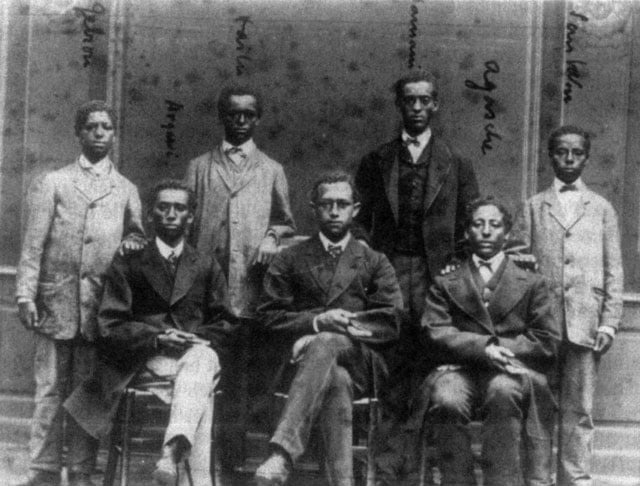[work in progress]
Languages in the Horn of Africa
1. Oromo
- Barkii in Ankober, 1839-41
- Ruufoo in Korntal and the Basel area, 1866‒69
- Aläqa Zännäb and his co-translators in the Horn of Africa, approx. 1867‒76:
· Jaagan
· Waaree, † 1870/71
· Sholan
· Gäbrä Maryam
2. Amharic
Group of Ethiopian students from St. Chrischona Pilgrim Mission’s Training Institute in late 1871 (or early 1872):

[cf. W. Smidt, “St. Chrischona Pilgermission”, in Encyclopaedia Aethiopica,
vol. 4, p. 731. Wiesbaden: Harrassowitz, 2010]
The following students are very likely to have assisted Krapf in revising the Amharic Bible during his stays at St Chrischona in the early 1870s. Wolde Sellasie and Gebru Desta also worked with Krapf for several months in Korntal (Germany):
- Mika’el Aregawi
lived in Switzerland and Southwest Germany from May 1868 until October 1873. - Haylu Wossen
stayed in Switzerland from May/June 1871 until his death on 19 July 1872. - Gebru Desta (alias Gobaw)
lived in Switzerland and Southwest Germany from May/June 1871 until late 1877. - Wolde Sellasie Kenfu
stayed in Switzerland and Southwest Germany from May 1872 until Spring 1874.
3. Tigrinya
Matewos (ca. 1800 – after 1840s)
Matewos was hired to translate the 4 Gospel into Tigrinya. His version was revised by Isenberg and published by Krapf.
Further reading
Smidt, Wolbert. “Matewos”, in Encyclopaedia Aethiopica, vol. 5, ed. A. Baussi in cooperation with S. Uhlig, p. 421. Wiesbaden: Harrassowitz, 2014:
- Smidt refers to his article “Matewos” in Biographisch-Bibliographisches Kirchenlexikon, vol. 30, ed. T. Bautz, cols. 971‒74. Hamm: Bautz, 2009. (Lit.)
East African Languages
4. Kiswahili
4.1 Sheikh Ali Ben Mueddin
From Barawa; qadi of Mombasa, helped Krapf translate Genesis into Kiswahili (Krapf, Travels, p. 131).
4.2 Amri
A servant of Krapf, who also helped him as a resource person in linguistic and ethnological matters. (Barsik, Wissenschaft, p. 92)
4.3 Muidani
A Muslim who knew Arabic and Kiswahli; assisted Krapf in translating the Bible. (Barsik, p. 92)
5. Mijikenda
5.1 Sheikh Ali Ben Mueddin
(He appears to have been more proficient in Kiswahili than in Mijikenda)
6. Kikamba
?
7. Kipokomo
Hajji Omar
A Pokomo from Takaungu; converted to Islam.
8. Chiyao (alias Kihiáu)
Kamanga Lad
A person from a neighbouring ethnic group who nevertheless spoke this language.
9. Orma (Southern Oromo)
Hajji Omar
s. above (Kipokomo)
References
Bursik, Heinrich. „Wissenschaft u. Mission sollen sich aufs innigste miteinander befreunden“. Geographie und Sprachwissenschaft als Instrumente der Mission – der Afrikareisende Johann Ludwig Krapf. Saarbrücken: AV Akademikerverlag, 2014. [= M.A. thesis; view online; esp. p. 91-92]
Krapf, Johann Ludwig. Vocabulary of Six East African Languages (Kisuáheli, Kiníka, Kikámba, Kipokómo, Kihiáu, Kigálla) composed by the Revd. Dr. J. L. Krapf. Tübingen: Fues, 1850. [Google Books]
Krapf, Johann Ludwig. Travels, Researches, and Missionary Labours during an Eighteen Years’ Residence in Eastern Africa […; abridged version of Krapf (1858), Reisen]. London: Trübner, 1860. [View online]